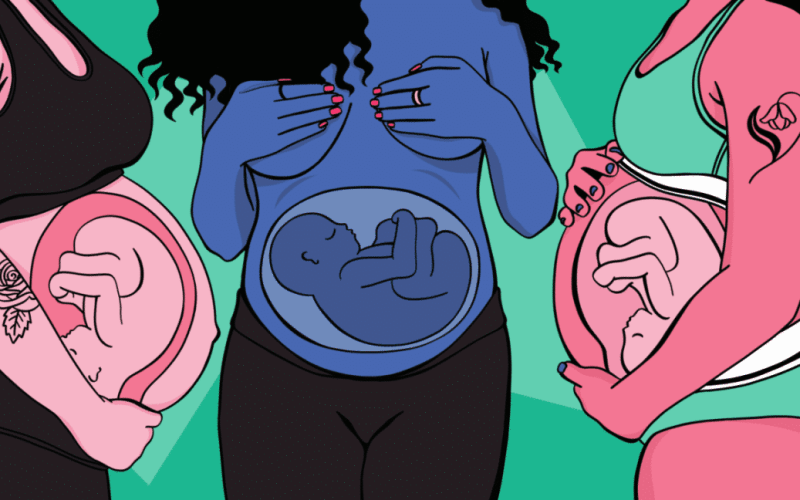When I was younger, I vividly recall how my mum would tell me to place a hand in her tummy to feel the movement of younger siblings a few months before they were born.
It was something I always looked forward to doing whenever she was pregnant, and it made me wonder if those movements meant that the baby was changing positions and if the position change meant different things.
From the beginning of the second and early third trimester of pregnancy, you might feel a lot of kicking and wiggling, and your baby may sometimes engage in twists and turns.
By the ninth month of your pregnancy, the child must have grown really big and had less room for all those movements. As your due date approaches, your baby’s position becomes more vital.
It is essential because your baby must assume a good position to aid delivery. Your doctor must continuously check your child’s position in the womb, mostly during this last month.
As you read on, you will learn the meanings of transverse, anterior, breech, and posterior, which doctors often use to describe a baby’s position in the womb.
This write-up also explains what to do if your baby isn’t in the right position before your due date.
What is an Anterior Position?
When the doctor says a baby is in an anterior position, the child’s head is down, and its face looks at your back.
The baby’s chin is tucked into its chest, and its head is set to pass through the mother’s pelvis.
The baby can flex its neck and head and tuck its chin into its chest. This pain is usually referred to as the cephalic presentation or occipital-anterior.
The narrow part of the child’s head can press on the mother’s cervix, helping it to open during delivery.
Most babies assume this position between the 33rd and 36th week of pregnancy, the ideal and safest time for a child’s delivery.
What is the Posterior Position?
In the posterior position, the child’s head faces down, but its face looks towards the mother’s stomach instead of towards her back. This kind of child position is called the heartbeat-posterior (OP) position.
About one-tenth to one-third of babies assume this position in the first stage of labor, but most of these babies spontaneously turn in the right direction before birth.
However, there are cases where the babies do not readjust to the anterior position and remain in this position until they’re delivered.
A child in this position would increase the chances of the mother having prolonged delivery and also experiencing severe back pain.
Most doctors make sure an epidural is available to help ease some of the pain during childbirth.
What is the Breech Position?
When a doctor says a baby is breached, it means that the baby is positioned straight up with its butt and feet facing down.
Three Positions Represent a Breech
- A complete breech: In a complete breech, the child’s buttocks are pointed towards the birth canal with its legs folded at the knees and feet close to the buttocks
- A frank breech: In a frank breech, the baby’s buttocks are towards the birth canal, but its legs are straight in front of it, positioning its feet near the head.
- A footing breech: when there is a footing breach, one or both of the child’s feet point towards the birth canal.
A breech position is not in any way ideal for childbirth, although most children born in breech positions are healthy. However, they stand a higher risk of experiencing trauma during birth and also defects.
While in a normal birth, the child’s head is the first to emerge through the vaginal canal, in a breech birth, the head appears last, which makes it difficult for the body to pass through the canal.
The breech position can also be very problematic because it increases the chance of creating a loop in the child’s umbilical cord, and that could potentially cause an injury to the child if it is delivered vaginally.
If your doctor detects the breech at an early stage, he or she may prescribe tips on how to help turn your baby in the right direction before your due date.
Among the techniques available for turning children in breech positions, most doctors prefer: backward as an external cephalic version (ECV).
The external cephalic version involves applying pressure to the mother’s abdomen. Although the mother may feel uncomfortable, this procedure is not dangerous.
Also, while the procedure is ongoing, the doctor will pay close attention to the baby’s heartbeat and stop immediately if he or she senses any problems.
About half the time, people used the external cephalic version technique to turn a breasted child, which was successful. However, if the ECV doesn’t work for you, the doctors would suggest that you undergo a cesarean session to help bring out the baby.
Such is usually the situation with a falling breech. In such cases, there is the possibility of the child’s umbilical cord squeezing as it struggles to pass through the birth canal, and this would ultimately cut off oxygen and blood supply.
What is the Transverse Lie Position?
The transverse lie position means that the baby is lying horizontally in the mother’s uterus. This position is scarce at delivery because most babies would automatically turn themselves face down before the due date.
However, if a doctor notices that a child has used this position before delivery, he would have no choice but to carry out a cesarean section for the mother.
The reason there will be the need for a cesarean section is that there is a high chance of the umbilical cord prolapsing.
When the mother’s water breaks, the umbilical cord might come out before the child. Umbilical cord prolapse is always considered an emergency, and the Next section must be carried out immediately.
Belly Mapping
If you want to track your baby’s position before delivery, belly marking, which usually begins at eight months, is a very effective method.
The equipment required is a door, which will be used to visualize or mimic your baby’s position in the womb, and a washable marker for marking.
The best time to do a daily market is immediately after you leave a section with your doctor. This way, you can easily tell if your baby’s head is facing the right direction.
Belly Marking Steps
To engage in belly marking, lie down on your bed and put your hand on your abdomen, trying to feel for your baby’s head.
The child’s head usually feels like a mini ball, so mark it on your belly once you spot it. If you have a fetoscope or during an ultrasound, look for the spot of your baby’s heartbeat and mark it on your tummy.
Next, you have to locate your baby’s butt. It is usually round and hard, so when you spot it, make a mark on your stomach, then play around in different positions with the doll based on the markings.
Can I Turn My Baby?
Although it is expected that all babies position themselves correctly before their mother goes into labor, there are times when your baby might not.
So, you need to know your child’s position before your due date because the exact position of a baby in the womb could lead to some complications during delivery.
Nevertheless, there are a few methods you can use to coerce your unborn child into staying in the right position.
- Spend some time every day sitting on an exercise ball or a birth ball
- When sitting down, tilt your pelvis forward instead of tipping it backward.
- If your job requires you to sit for an extended period, take breaks by walking around occasionally.
- Ensure you always sit in a position that allows your hips to be higher than your knees every time.
- If possible, get on your knees and hands up to four times for a few minutes daily. This will help adjust your baby to an anterior position.
- If you drive, add a cushion to the driver’s seat so that you are seated up high and can tilt your bottom forward.
If you try all of these tips and still don’t help position your baby, it may be due to the shape of your pelvis rather than your posture. In this case, a cesarean delivery may become necessary.
As a pregnant mother, it is essential that you feed well, relax as much as possible, and exercise so that you are fit enough for childbirth. It is also vital to stay positive and worry less.
You cannot be relaxed about your baby’s position until the 8th and 9th months of your pregnancy, as he or she will most likely be in an anterior position before delivery.









